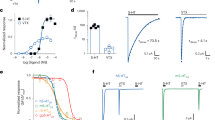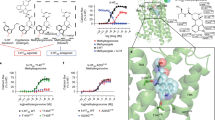Abstract
NEUROPSYCHIATRIC disorders such as anxiety, depression, migraine, vasospasm and epilepsy may involve different subtypes of the 5-hydroxytryptamine (5-HT) receptor1,2. The IB subtype, which has a unique pharmacology, was first identified in rodent brain3–7. But a similar receptor could not be detected in human brain6, suggesting the absence in man of a receptor with equivalent function. Recently a human receptor gene was isolated (designated 5-HT1B receptor8,9, 5-HT1Dβ receptor10,11, or S12 receptor12) which shares 93% identity of the deduced protein sequence with rodent 5-HT1B receptors13–15. Although this receptor is identical to rodent 5-HT1B receptors in binding to 5-HT, it differs profoundly in binding to many drugs. Here we show that replacement of a single amino acid in the human receptor (threonine at residue 355) with a corresponding asparagine found in rodent 5-HT1B receptors renders the pharmacology of the receptors essentially identical. This demonstrates that the human gene does indeed encode a 1B receptor, which is likely to have the same biological functions as the rodent 5-HT1B receptor. In addition, these findings show that minute sequence differences between homologues of the same receptor from different species can cause large pharmacological variation. Thus, drug–receptor interactions should not be extrapolated from animal to human species without verification.
Similar content being viewed by others
References
Hartig, P. R. et al. Neuropsychopharmacology 3, 335–347 (1990).
Peroutka, S. J. Neuropharmacology 31, 609–613 (1992).
Pedigo, N. W., Yamamura, H. I. & Nelson, D. L. J. Neurochem. 36, 220–226 (1981).
Schnellman, R. G., Waters, S. J. & Nelson, D. L. J. Neurochem. 42, 65–70 (1984).
Hoyer, D., Engel, G. & Kalkman, H. O. Eur. J. Pharmac. 118, 1–12 (1985).
Hoyer, D., Engel, G. & Kalkman, H. O. Eur. J. Pharmac. 118, 13–23 (1985).
Hoyer, D. & Middlemiss, D. N. Trends pharmac. Sci. 10, 130–132 (1989).
Jin, H. et al. J. biol. Chem. 267, 5735–5738 (1992).
Hamblin, M. W., Metcalf, M. A., McGuffin, R. W. & Karpells, S. Biochem. biophys. Res. Commun. 184, 752–759 (1992).
Weinshank, R. L. et al. Proc. natn. Acad. Sci. U.S.A. 89, 3630–3634 (1992).
Demchyshyn, L. et al. Proc. natn. Acad. Sci. U.S.A. 89, 5522–5526 (1992).
Olav-Levy, F. et al. J. biol. Chem. 267, 7553–7562 (1992).
Voigt, M. M., Laurie, D. J., Seeburg, P. H. & Bach, A. EMBO J. 10, 4017–4023 (1991).
Adham, N. et al. Molec. Pharmac. 41, 1–7 (1992).
Maroteaux, L. et al. Proc. natn. Acad. Sci. U.S.A. 89, 3020–3024 (1992).
Suryanarayana, A., Daunt, D. A., VonZastrow, M. & Kobilka, B. K. J. biol. Chem. 266, 15488–15492 (1991).
Guan, X. G., Peroutka, S. J. & Kobilka, B. K. Molec. Pharmac. 41, 695–698 (1992).
Albert, P. R. et al. J. biol. Chem. 265, 5825–5832 (1990).
Kobilka, B. K. et al. Nature 329, 75–79 (1987).
Fargin, A. et al. J. biol. Chem. 264, 4848–4852 (1989).
Findlay, J. & Eliopoulos, E. Trends pharmac. Sci. 11, 492–499 (1990).
Hamblin, M. W. & Metcalf, M. A. Molec. Pharmac. 40, 143–148 (1991).
Ashkenazi, A., Peralta, E. G., Winslow, J. W., Ramachandran, J. & Capon, D. J. Cell 56, 487–493.
McPherson, G. A. Comp Prog. Biomed. 17, 107–114 (1983).
Munson, P. J. & Rodbard, D. Analyt. Biochem. 107, 220–239 (1989).
Author information
Authors and Affiliations
Rights and permissions
About this article
Cite this article
Oksenberg, D., Marsters, S., O'Dowd, B. et al. A single amino-acid difference confers major pharmacological variation between human and rodent 5-HT1B receptors. Nature 360, 161–163 (1992). https://doi.org/10.1038/360161a0
Received:
Accepted:
Issue Date:
DOI: https://doi.org/10.1038/360161a0
- Springer Nature Limited
This article is cited by
-
The discovery, structure, and function of 5-HTR1E serotonin receptor
Cell Communication and Signaling (2023)
-
Serotonin and beyond—a tribute to Manfred Göthert (1939-2019)
Naunyn-Schmiedeberg's Archives of Pharmacology (2021)
-
The 5-HT1B receptor - a potential target for antidepressant treatment
Psychopharmacology (2018)
-
ABC transporter-dependent brain uptake of the 5-HT1B receptor radioligand [11C]AZ10419369: a comparative PET study in mouse, rat, and guinea pig
EJNMMI Research (2014)
-
The GPCR Network: a large-scale collaboration to determine human GPCR structure and function
Nature Reviews Drug Discovery (2013)





